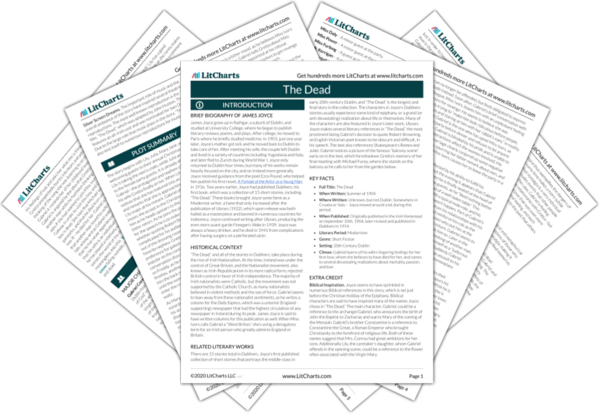Welcome to the LitCharts study guide on James Joyce's The Dead. Created by the original team behind SparkNotes, LitCharts are the world's best literature guides.
The Dead: Introduction
The Dead: Plot Summary
The Dead: Detailed Summary & Analysis
The Dead: Themes
The Dead: Quotes
The Dead: Characters
The Dead: Symbols
The Dead: Literary Devices
The Dead: Theme Wheel
Brief Biography of James Joyce

Historical Context of The Dead
Other Books Related to The Dead
- Full Title: The Dead
- When Written: Summer of 1904
- Where Written: Unknown, but not Dublin. Somewhere in Croatia or Italy – Joyce moved around a lot during this period.
- When Published: Originally published in the Irish Homestead on September 10th, 1904, later revised and published in Dubliners in 1914.
- Literary Period: Modernism
- Genre: Short Fiction
- Setting: 20th Century Dublin
- Climax: Gabriel learns of his wife’s lingering feelings for her first love, whom she believes to have died for her, and comes to several devastating realizations about mortality, passion, and love
Extra Credit for The Dead
Biblical Inspiration. Joyce seems to have sprinkled in numerous Biblical references in this story, which is set just before the Christian holiday of the Epiphany. Biblical characters are said to have inspired many of the names Joyce chose in “The Dead.” The main character, Gabriel, could be a reference to the archangel Gabriel, who announces the birth of John the Baptist to Zacharias and warns Mary of the coming of the Messiah. Gabriel’s brother Constantine is a reference to Constantine the Great, a Roman Emperor who brought Christianity to the forefront of religious life. Both of these names suggest that Mrs. Conroy had great ambitions for her sons. Additionally Lily, the caretaker’s daughter, whom Gabriel offends in the opening scene, could be a reference to the flower often associated with the Virgin Mary.
Silver Screen Dreams. The important role of music and the overall ambiance of the story have inspired several theatrical reproductions. The most well known reproduction is the 1987 film, “The Dead,” which was adapted by John Huston. The film features an all-Irish cast and was nominated for two Oscars. Due to the large role that music plays in the story, “The Dead” also lent itself to numerous reproductions for musical theater.












